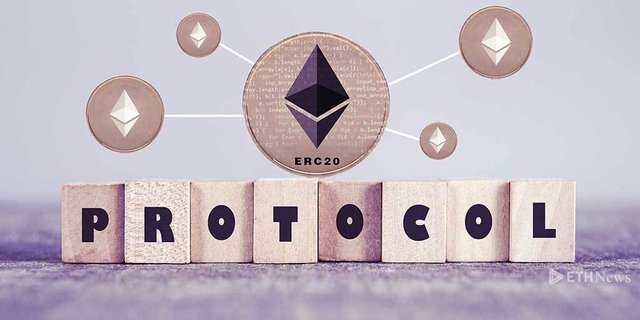When Bitcoin reach its lock-in threshold for SegWit on August 8, 2017, I was convinced of two things: 1) Bitcoin’s price would soar 2) There are now two ecosystems emerging in crypto.
1. The Ethereum Ecosystem
Photo credit: https://www.ethnews.com/erc20-the-ethereum-token-standard
The first ecosystem that came onto the cryptoscene was the Ethereum(ETH) and ERC-20 ecosystem which included tokens such as Golem(GNT) and Augur(REP).
Being built on the Ethereum blockchain, ERC-20 tokens do not stand alone. They require ETH in order to be sent. It’s in this unique dependent relationship that we see how the success of ETH can be highly influenced by the success of the utility platforms of ERC-20 tokens.
The relationship of ERC-2o tokens between one another are also more intertwined than what may appear on the surface. These tokens are actually quite similar to one another due to the ERC-20 standard. This creates a unique relationship between the tokens themselves. This is how Jean-Pierre Buntinx explains it in his article for the Merkle:
“The ERC-20 standard (also) makes the assets more easily interchangeable and ensure they can work with Dapps adhering to the same standard.”
These two reasons demonstrate just how intimately tied ETH and ERC-20 are to one another. Should Ethereum maintain its Market Cap prevalence in the years to come, it would mean an entire ecosystem of tokens is behind it.
2. The Segwit Ecosystem

Prior to August 8, there were a handful of coins that had implemented Segwit before Bitcoin such as Litecoin, Digibyte, and Vertcoin. There was much excitement over this new protocol that would help facilitate future tech such as MAST and the Lightning Network. But perhaps the most significant application of Segwit is Atomic Swaps via the Lightning Network.
In short, Atomic Swaps(AS) would enable cross-chain transactions between two different currencies such as BTC and LTC. There are several advantages to this:
- You wouldn’t have to go through the trouble of an exchange to get the coin you wanted.
- The fee for Atomic Swaps through the LN would be less than if you bought it through an exchange.
- The transactions would be instant.
Although Atomic Swaps could technically work without Segwit, transactions would frequently get stuck without a malleability fix. In light of this, it’s pretty safe to say that Atomic Swaps would only be available through Segwit-enabled coins.
Now these coins certainly were their own ecosystem prior to Bitcoin. However, Atomic swaps itself wouldn’t have been a compelling of enough reason to facilitate sufficient use to influence each other’s market value. The reason for this is that Litecoin was the only currency in the top 10 in Market Cap with significant volume. But the moment Bitcoin reached the threshold for locking in Segwit, the game changed because Bitcoin brought with it these 3 things:
- $245.5 billion in Market Cap
- $20 billion dollars in volume in the past 24 hours
- 37% dominance of the entire cryptomarket
*Statistics reported as of 1/2/18 from www.coinmarketcap.com
These market factors create transactional pressure within the ecosystem which will directly affect the market value of each coin. By implementing Segwit, Bitcoin essentially legitimized a whole new ecosystem into cryptocurrency.
The Two Different Philosophies of Growth
The manner by which the Ethereum and Segwit ecosystems are established isn’t the only thing that separates them. They also have different philosophies of growth.
1. The Ethereum Ecosystem

If you haven’t noticed by now, the ETH/ERC-20 ecosystem is heavily focused on practical applications. ETH is a token to access Ethereum’s Virtual Machine. GNT is a payment token in order to access decentralized computing power. OMG is a token to access financial technology for use in mainstream digital wallets. All of these tokens and ETH serve a functional purpose in the world.
In other words, their philosophy of growth is through utility. The more the ERC-20 platforms are used, the more valuable the ecosystem gets.
Even though up and coming coins such as EOS and NEO are currently seeking to dethrone this ecosystem, they have a long path ahead of them with just how well established the Ethereum ecosystem already is.
2. The Segwit Ecosystem

The Segwit ecosystem’s philosophy of growth is fairly simple: cash. Bitcoin, Litecoin, and Vertcoin were initially created to be used as a currency and the technology they are implementing reflects that. Segwit decreases transactional data recorded in blocks thereby alleviating stress from heavy volumes, the Lightning Network enables instant settlements for a nominal fee, and Atomic Swaps allow for accessible trading.
However, this philosophy may be slowly changing. Digibyte has already departed from it by creating applications such as Digusign which offers quick digital signatures for medical records. Johnson Lau has even proposed a colored coin protocol which would allow applications and tokens to be implemented onto BTC/LTC just like ETH.
Final Thoughts
Currently there are over 1,000 currencies listed on coinmarketcap. Of these, there are certainly coins that can stand alone. XRP and NEM have consistently remained in the top 10 spot in Market Cap over this past month. Also, Bitcoin has historically proven that a single currency can dominate the market. However, I would not be surprised if the coins that maintain market dominance moving forward are the ones who are tied together.
Discussion Questions:
- Which ecosystem do you think has a better shot of dominating the market?
- What other ecosystems do you see in the cryptomarket?
Hi! I am a robot. I just upvoted you! I found similar content that readers might be interested in:
https://medium.com/@ecurrencyhodler/the-two-emerging-ecosystems-in-crypto-a8a9feade738
Downvoting a post can decrease pending rewards and make it less visible. Common reasons:
Submit